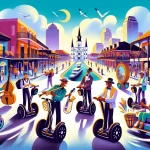New Orleans, a celebrated city with a distinct culture, storied past, and culinary prowess, presents an appealing landscape for outdoor enthusiasts seeking scenic routes to walk or jog. With its level terrain and mild climate, the city offers an ideal setting for those aiming to embrace an active lifestyle while immersing themselves in its captivating allure.
In This Article
TL;DR
- New Orleans’ flat topography and subtropical climate create favorable conditions for outdoor activities like jogging and walking.
- Selecting appropriate routes is essential for safety and enjoyment, as the city offers a diverse range of options, from urban trails to picturesque parks.
- The city’s commitment to maintaining and enhancing pedestrian pathways has led to well-maintained routes for joggers and walkers.
Popular Jogging and Walking Routes in New Orleans
Audubon Park
Situated in the city’s Uptown neighborhood, Audubon Park is a verdant oasis that offers respite from New Orleans‘ bustling streets. Spanning over 350 acres, this urban park boasts a 1.8-mile paved trail winding through lush greenery and around a picturesque lagoon. The well-maintained trail features water fountains, restrooms, and exercise stations, making it an ideal destination for joggers and walkers of all skill levels.
Crescent Park
Crescent Park, located along the Mississippi River’s banks, offers a unique opportunity to experience the city’s riverfront while engaging in outdoor activities. This 1.4-mile linear park features a paved trail meandering through lush greenery, providing stunning views of the iconic river and the city skyline. With its flat terrain and ample parking facilities, Crescent Park is a popular destination for joggers and walkers seeking a scenic and accessible route.
Lafitte Greenway
The Lafitte Greenway is a 2.6-mile urban trail winding through the heart of New Orleans, connecting several neighborhoods and offering a unique perspective on the city’s distinctive character. Developed along an abandoned railroad corridor, the Greenway features a paved path perfect for joggers and walkers. Along the route, visitors can enjoy public art installations, community gardens, and amenities like water fountains and exercise stations.
Safety Tips for Joggers and Walkers in New Orleans
Weather Considerations
New Orleans’ subtropical climate can present challenges for outdoor enthusiasts, particularly during the hot and humid summer months. To ensure a safe and enjoyable experience, it is recommended to jog or walk during cooler hours, such as early morning or evening. Additionally, staying hydrated and wearing lightweight, breathable clothing can help mitigate the effects of the city’s humidity.
Personal Safety
While New Orleans is generally safe for pedestrians, it is advisable to take precautions when jogging or walking in urban areas. Choosing well-lit and populated routes, carrying a personal safety device, and being aware of your surroundings can help ensure a safe and enjoyable experience. Additionally, it is recommended to avoid wearing headphones or engaging in activities that may distract you from your surroundings.
Community and Health Benefits
Physical and Mental Health Benefits
Regular jogging and walking offer numerous physical and mental health benefits, and New Orleans’ scenic routes provide an added incentive to embrace an active lifestyle. Engaging in these activities can improve cardiovascular health, strengthen muscles, and boost overall fitness levels. Additionally, the city’s picturesque parks and riverfront trails can contribute to mental well-being by providing a peaceful escape from the hustle and bustle of urban life.
Community Engagement
New Orleans is home to a vibrant community of joggers and walkers who regularly participate in organized events and group activities. From local running clubs to charity walks and marathons, these events offer opportunities for individuals to connect with like-minded individuals while promoting a sense of community and camaraderie. Participating in such events can not only enhance one’s fitness journey but also foster a deeper appreciation for the city’s distinctive cultural heritage.
Navigational Tools and Resources
Mobile Apps and Maps
In today’s digital age, a variety of mobile apps and online resources are available to assist joggers and walkers in navigating New Orleans’ routes. Apps like Strava and MapMyRun offer detailed maps, route planning tools, and the ability to track progress and share achievements with others. Additionally, local resources like the New Orleans Recreation Development Commission (NORDC) website provide up-to-date information on trail conditions and upcoming events.
Signage and Mile Markers
Many of New Orleans’ popular jogging and walking routes are well-marked with signage and mile markers, making it easier for visitors and locals alike to navigate and track their progress. These markers not only provide directional guidance but also serve as motivational tools for those training for specific distances or events.
Maintenance and Development of Walking and Jogging Paths
City Initiatives
Recognizing the importance of promoting an active and healthy lifestyle, the City of New Orleans has implemented various initiatives to improve and expand its network of pedestrian pathways. Recent projects have included the renovation of existing trails, the addition of new amenities like water fountains and exercise stations, and the development of new greenways and urban trails.
Community Involvement
Beyond city-led efforts, local community organizations and advocacy groups play a crucial role in the maintenance and development of New Orleans’ jogging and walking routes. These groups often organize cleanup events, fundraisers, and awareness campaigns to ensure that the city’s outdoor spaces remain well-maintained and accessible to all.
Comparisons to Other Cities
Similarities and Differences in Urban Planning
While New Orleans shares similarities with other cities in terms of its commitment to promoting pedestrian-friendly environments, its unique geography and cultural heritage set it apart. Unlike cities with more varied topography, New Orleans’ flat terrain presents both challenges and opportunities in urban planning and outdoor recreation. Additionally, the city’s distinctive character, influenced by its French, Spanish, and Creole roots, has shaped the design and character of its public spaces in a way that is uniquely New Orleans.
Lessons Learned and Best Practices
As cities around the world strive to create more livable and sustainable urban environments, New Orleans’ experience in developing and maintaining its jogging and walking routes offers valuable lessons and best practices. From the importance of community engagement and collaboration to the need for ongoing maintenance and adaptation, the city’s journey serves as a model for others seeking to promote active lifestyles and enhance the quality of life for their residents.
By embracing its unique landscape and cultural heritage, New Orleans has emerged as a destination that not only celebrates its rich history but also fosters a vibrant and active community. Whether you’re a local resident or a visitor seeking to experience the city’s charm on foot, the city’s jogging and walking routes offer a unique and unforgettable way to explore the sights, sounds, and flavors that make New Orleans truly one-of-a-kind.






